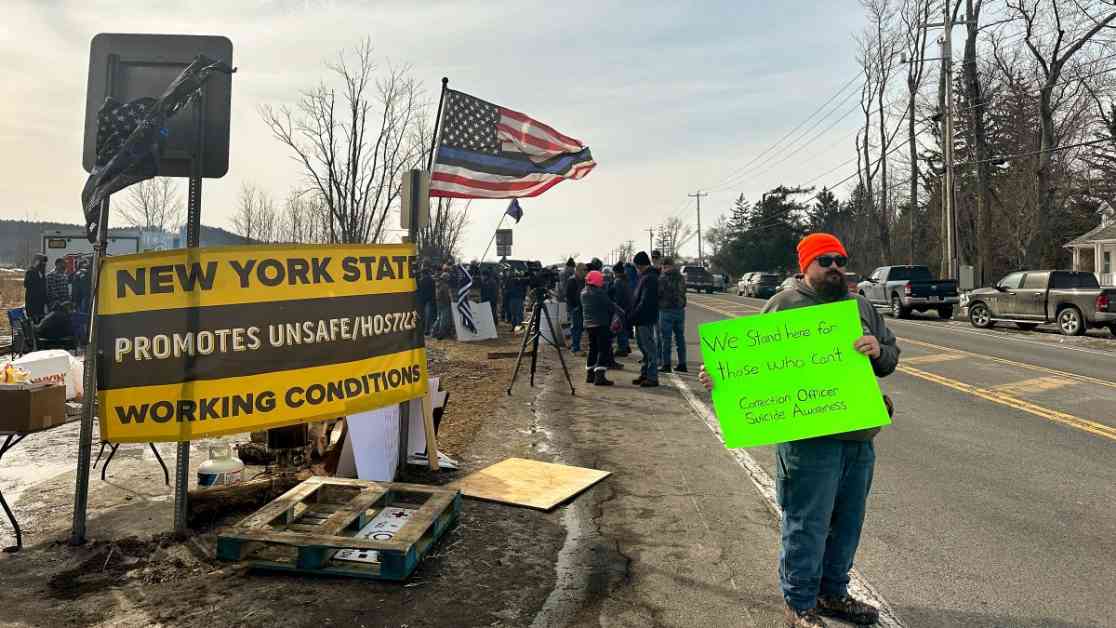New York Prison Strike Ends: Hochul Announces Resolution
After more than a week of turmoil in the New York state prison system, Governor Kathy Hochul revealed a breakthrough late Thursday evening. The governor declared that an agreement had been reached to put an end to the unauthorized strike by prison workers that had caused significant disruption.
Hochul disclosed that the state and the union representing the striking correctional employees had come to a binding resolution following four days of intensive mediation discussions. The mediator, Martin Scheinman, outlined the terms of the agreement in a detailed seven-page memo known as a binding consent award, emphasizing the necessity for the workers to resume their duties by Saturday to avoid facing disciplinary action.
The agreement, which was hailed as a significant step towards addressing the ongoing staffing shortages and reducing mandatory 24-hour overtime shifts, was a pivotal moment in the ongoing conflict. Governor Hochul highlighted that the mediated settlement aimed to address many of the workers’ grievances, ensuring the safety of all New Yorkers and preventing any future unauthorized work stoppages.
In a statement, Governor Hochul reiterated, “My top priority is the safety of all New Yorkers, and for the past 11 days, I have deployed every possible State resource to protect the well-being of correction officers, the incarcerated population, and local communities across New York.”
Key Concessions and Provisions in the Agreement
As part of the agreement, striking workers were able to secure several key concessions, including a temporary increase in overtime pay, a potential adjustment in the pay scale, and the suspension of a prison reform law that they believed compromised safety within correctional facilities.
For the next month, overtime pay will be calculated at a rate of 2½ times the regular pay instead of the usual 1½ times, offering a temporary relief to the workers facing extended shifts. Additionally, the state committed to completing its evaluation within the next four months to potentially raise the salary grade for officers and sergeants, addressing a longstanding concern of the union.
The suspension of the reform law, which restricted the use of solitary confinement, was extended for 90 days to allow the state to assess its impact on staff and inmate safety. This critical provision underscored the importance of balancing prison security with the well-being of those incarcerated.
Mediator’s Insights and Resolution Details
Martin Scheinman, a highly respected mediator with vast experience in resolving complex disputes, commended both parties for their dedication to finding practical solutions for the workforce. Scheinman, who serves as the permanent arbitrator for Major League Baseball and the National Hockey League, highlighted the strained relationship between the state and the prison workers, emphasizing the need for collaborative efforts to rebuild trust.
In his memo outlining the agreement, Scheinman noted, “What has become clear during the mediation is the relationship between the parties and the workforce is strained… It is obvious this erosion did not happen all at once.” This candid assessment shed light on the underlying issues that had led to the breakdown in communication and cooperation.
The National Guard, which had been deployed to various prisons to fill in for the striking workers, will gradually withdraw as correctional officers return to their posts. However, National Guard members remaining on-site will play a crucial role in preventing the imposition of mandatory 24-hour overtime shifts on prison workers, ensuring a smoother transition back to normal operations.
As the state and the union forge ahead with plans to establish a committee to evaluate staffing and operational challenges at each facility, the focus remains on creating a safer and more sustainable environment for both correctional staff and inmates. The spirit of cooperation and compromise that culminated in this agreement serves as a testament to the power of dialogue and mediation in resolving complex labor disputes.
In conclusion, the resolution of the strike marks a significant milestone in restoring stability to the New York state prison system and fostering a renewed sense of collaboration between all stakeholders involved. The road ahead may still present challenges, but with a shared commitment to addressing the root causes of discontent and implementing lasting reforms, the future looks promising for all those impacted by this transformative agreement.












